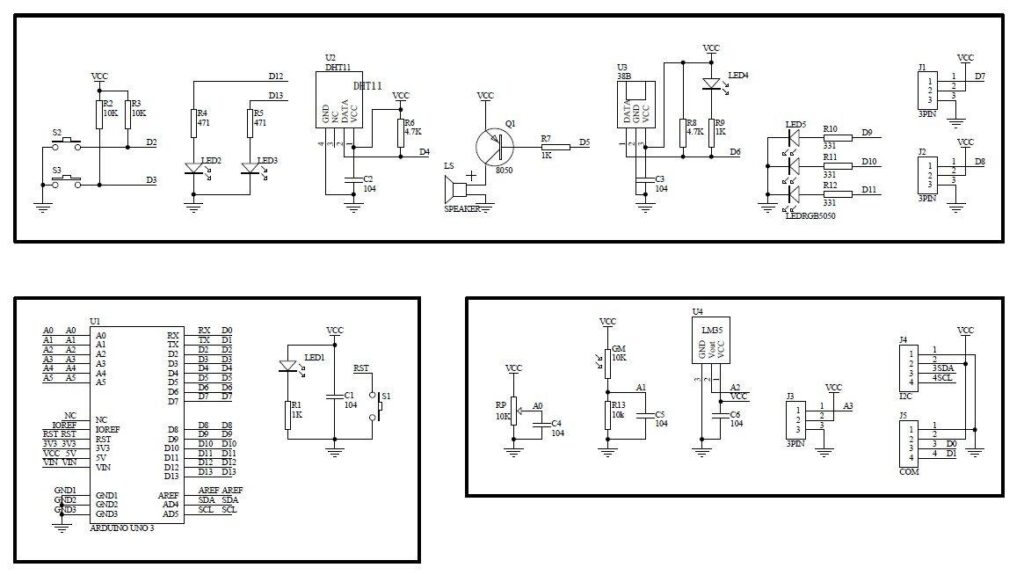Another shield that I recommend for beginners is the Easy module shield, you can see it in the images below. It is very similar to the open smart rich shield but because the open smart has a 7 segment display that makes it more useful in my book. This is still a very useful shield though.
and now the schematic, this is in our github link later on
First of all we will look at the various features of this shield
The shield has 2 buttons, 2 LEDs – one red one and 1 blue one, 1 RGB led, 1 DHT11 temperature and humidity sensor, 1 potentiometer, 1 buzzer, 1 LM35 temperature sensor, 1 LDR and1 Infrared reciever.
There are various connectors for connecting external devices – there is an I2C connector, RS232 connector and also pins D7, D8 and A3 come out to external headers so these can be used for other purposes
Lets look at a couple of code examples
Temperature sensor comparison
This example will compare the DHT11 and LM35 temperature values – it needs the SimpleDHT library
[codesyntax lang=”cpp”]
#include <SimpleDHT.h>
int pinDHT11 = 4;
float tempC;
int tempPin = 2;
byte temperature = 0;
byte humidity = 0;
SimpleDHT11 dht11;
void setup()
{
Serial.begin(9600);
}
void loop()
{
tempC = analogRead(tempPin); //read the value from the sensor
tempC = (5.0 * tempC * 100.0)/1024.0; //convert the analog data to temperature
if (dht11.read(pinDHT11, &temperature, &humidity, NULL))
{
Serial.print("Read DHT11 failed.");
return;
}
Serial.print("DHT11 - ");
Serial.print((int)temperature);
Serial.print(" *C, ");
Serial.print("LM35 - ");
Serial.print((byte)tempC);
Serial.println(" *C");
delay(1000);
}
[/codesyntax]
RGB led example
Just a simple example for the RGB led
[codesyntax lang=”cpp”]
#define redLed 9
#define greenLed 10
#define blueLed 11
void setup()
{
pinMode(redLed, OUTPUT);
pinMode(greenLed, OUTPUT);
pinMode(blueLed, OUTPUT);
}
void loop()
{
for (int i=0; i <= 255; i++)
{
setColor(i, 0, 0); // red
delay(10);
}
}
void setColor(int red, int green, int blue)
{
analogWrite(redLed, red);
analogWrite(greenLed, green);
analogWrite(blueLed, blue);
}
[/codesyntax]
We have more examples at our github repo
A very low cost shield this one, under $2 for this one
keyestudio Multi-purpose Shield V1 for arduino starter – $1.23
Summary
Another useful shield for learning arduino development, I prefer the Open smart rich shield but this one does come in a couple of dollars cheaper so if you are on a tight budget you may want to consider this one.



